Life Can Be Beautiful
You can't
tell a book by its cover, but you can tell a woman by her home.
This place is
vivid and elegant -- it belongs to Joan...
by Prince Michael
Romanoff
Originally appeared in Modern Screen, November 1948
I am a modest man by nature, but truth compels me to tell you that there is something irresistible about Romanoff which attracts women, particularly beautiful women.
For example, a few days ago, Joan Crawford, that beautiful stalk of loveliness, walked into my magnificently operated restaurant. She took a front booth, and I, as is my wont, sat down beside her.
Excitement was dancing in her eyes, and a smile was waltzing on her lips. "Happy today?" I inquired with quiet charm.
Joan clasped her hands. "Mike," she said, "you know I recently adopted two more children and my house was a shambles for a while but I've finally got it fixed and you simply must come out and see it!"
I listened carefully as Joan Crawford described what she'd done to this wing and that room, and as she spoke, my mind pictured her home, and I resolved to visit it the very next afternoon.
I am glad to report to you that Joan Crawford's home is built in the grand or Romanoff manner. It has stature, elegance, size.
It's the kind of home you imagine a movie star should live in. It has tradition, memories; it reflects years of loving care, thoughtful collecting, and pleasurable living. It reflects Joan Crawford, an actress who has grown with her fame, who has developed a taste and refinement for cultural beauty and the verities of life.
This Crawford life is lived in part in a white English Regency -- an early 19th Century style -- house which is built in the shape of an H. The front of the H forms a courtyard into which guests like Romanoff, Gable, Tracy and other great actors may drive their cars. It's a tree-shaded course from where you call out, "Joan, Joan!" and determine whether the beauty is working in the kitchen to the left, resting in the bedroom upstairs, or playing with the babies in the children's wing on the right.
The house is large, of course, but being planned around two courtyards makes it seem compact.
If Joan is giving a party or expecting friends to drop by, she usually answers the front door herself. Otherwise, her butler lets you in to the mauve and white entrance hall.
Joan knows that Romanoff is a stickler for formality; and that is why on the afternoon I visited, the butler did his duty. I stepped into the entrance and immediately was impressed by the subtle colors and the exquisite accessories which greeted my royal eyes. That Crawford girl has a great feeling for color; she knows how well it may create mood and drama. The entrance hall is in grey with a wine-colored carpet, and the drawing room is painted in a faint mauve. The furniture is upholstered in purple, green and white hand-painted chintz, and the carpeting is white.
To step into Joan's drawing room from the bright California sun is like walking into a cool, shaded wood. At night the purple tones seem to change and dance with the firelight. And Romanoff gives you his solemn word, as a dramatic setting for an actress, that drawing room cannot be beat. It shows Crawford at her best, and Joan at her best, as any man can tell you, is unbeatable.
All her rooms are furnished with richly quilted chairs, leather-covered coffee tables, out-sized hassocks, and numerous indoor plants. But the finest decorate beauty in the house lies in its paintings, the odd bits of china, the unforgettable lamps.
These are the accessories which speak eloquently of the owner; these are the possessions which she chose herself; these are the signs of her soul.
In the front hall and drawing room, for example, Joan has a series of paintings by the French artist, Gagni. The oils are Parisian scenes -- the Paris I love so well -- the flower stalls, the Left Bank, la Place d' Opera.
Two built-in niches in the drawing room display her collection of miniature furniture, Dresden figurines and ivory chessmen. An upright harpsichord in the hall is one of the rarest and oldest musical pieces in existence anywhere.
As a matter of fact, the Crawford drawing room is filled with so many valuable and delicate objets d'art that Joan has almost decided that it's too delicate, too beautiful, too fragile a room in which her guests can have a good time. "I'm thinking," she told me, "of changing the color scheme, making it green and white with dashes of red." In the meantime, she loves the room, loves to relax in it, loves to close the white-panelled doors and read and knit by the hour.
Romanoff, however, prefers the playroom, for this is the comfortable little spot which contains the bar; and it's also the room in which Joan entertains intimate parties of four and six. The place is vitalized by a lot of daily traffic, a great deal of it supplied by Joan's adopted youngsters -- Christina practices her piano lessons here, Christopher pores through his comic magazines, and even the two babies, Cathy and Cynthia, like to practice walking bare-footed on the thick green carpet.
Because it sees so much use, the playroom was decorated to stand hard wear. The wall covering is leathered with a suede trim. The ash trays are made of heavy brass. (Romanoff was tempted to life a few for the restaurant). Two built-in couches are comfortable but sturdy, and even the plants in this practical room are of a hardier nature.
Observant devil that he is, Romanoff was quick to recognize the Oscar which Joan had won in 1945 for Mildred Pierce. It was standing on the bar. Nearby on the wall was a fine pastel drawing of Joan by the director of Humoresque -- Jean Negulesco. Jean signed the picture with his legend, "Avec tant d'admiration." ("With so much admiration.") I feel the same way about Joan.
I also reserve a good deal of Romanoff admiration for her dining room. It's a truly magnificent sight. It's large and well-furnished. The table can seat twenty guests easily. There was a time, before the war, when Joan used to give large dinner parties. Now, she gives merely one a year, and her invitations are sought after by the elite in Hollywood.
The dining room is French in style, the panelling and parquet floors being representative of the Napoleonic era. On either side of the room, however, there are a series of Chinese murals, so delicate that they must be covered with glass. At the far end of the room, in a bay window overlooking the swimming pool and the lavish beds of camellias, is a small round table which Joan uses more frequently than the large one.
She likes to arrange flower setups for the big table, however, and flanks the center spread with silver candelabra so that by candlelight, the dining room becomes a symphony or polished wood, gleaming silver, and fresh flowers.
From my description of her home thus far, what sort of woman would you say Joan Crawford was? Frilly, ornate, flamboyant, gracious, modern, sharp, rough, delicate, careless, or what?
If you haven't yet made up your mind, let Romanoff present some further clues. Let him present Crawford in her kitchen. This is always an excellent place in which a woman may reveal her true character.
Joan is as much at ease in the kitchen as she is on the screen. An early riser, she always breakfasts with her four children. She also insists on preparing her own eggs, and when it comes to cleaning up, she never leaves the kitchen anything but spotless.
She likes to know what's going on in the culinary department so that there's a glass door in her dressing room which looks directly down into the kitchen. The children call this passageway, "Alice Through The Looking Glass."
mama romanoff...
Peek in on the nursery. It's to the left of Joan's bedroom, upstairs. Each baby girl has her own crib, her own chest of drawers, her own toy boxes, her own wardrobe closet. Glance into the closet, and even Romanoff becomes maternal. The closets are filled with the cutest pinafores, bonnets, sun suits and dresses, all starched and hung like peppermint sticks in a candy shop.
Provide your children with the best, but don't spoil them. That's Joan's motto. And it's worked out beautifully with Christina and Christopher. These two make their own beds, keep their wardrobe neat and orderly, and take some responsibility in caring for their little sisters.
Joan is also training them to appreciate fine art and to be at ease with people of every sort. She says that she herself lacked both these qualities when she first came to Hollywood and she's determined to see that the children do not.
To this end, Joan has given Christina a beautiful 18th Century desk, also a collection of miniature furniture which a movie fan sent her. Christina is justifiably proud of her desk and she's old enough to appreciate the fine workmanship which went into the small chairs and tables.
It's long been a practice of Joan to let the children invite a guest to the house each Saturday for a luncheon. At these weekly parties Christina and Christopher understand that they must act as hostess and host and make their friends feel at home. This helps the children develop poise and confidence so that one day they will be able to entertain at Romanoff's. That day can't come soon enough for me.
Romanoff likes children but he likes their mothers so much more; so let's continue with Joan. Joan's sleeping quarters might be termed a suite. Her bed, for example, is located on an enclosed sleeping porch away from all noise. The porch can be flooded with sunlight because it's lined with windows, and by the same token, it can afford total darkness because these same windows are covered with draperies, heavily lined with black.
The sleeping porch is simply furnished. It contains a three-quarters sized bed, a night table loaded with books, a reading lamp, and a chest. It's almost ascetic in its simplicity.
The bedspread and draperies, however, are white and turquoise and shot with silver. They were woven and designed by Dorothy Liebes, the San Francisco artist, and they're really good enough for Romanoff.
So too, is Joan's sitting room, which boasts all the individual pieces of furniture she personally likes. There's her 18th Century desk, a large oval Sheraton coffee table, and a French Empire couch. The wallpaper is a delicate turquoise with large white, hand-painted chrysanthemums.
Adjoining the sitting room and almost a part of it because the same heavy white carpeting covers both rooms, is the dressing room with bath. The wall coverings here is a yellow glazed chintz with sprigs of flowers as a pattern. Even the doors to the wardobe closets (which are the size of ordinary rooms) are covered with the same material, and the effect is one of lolling in a sunny garden.
Joan's dressing table is mirrored and a masterpiece of organization. She can sit in front of her makeup mirror and reach her jewelry, stockings, combs -- in fact, everything but her dresses.
During the time she's dressing to go out in the evening, the two babies, Cathy and Cynthia, have their gayest fun. Joan puts each one of them in a drawer on either side of her dressing table. Then, while she's applying her lipstick or powdering her nose, the two bundles of mischief have a great time playing with her jewelry, cosmetics, and so forth.
That takes care of Joan Crawford and her indoor life. As you probably know, however, she's long been famous for her beautifully proportioned figure. She maintains her curves by swimming, riding, and playing tennis. She has a large pool, and on either side of the pool, a small building. One of these is a dressing room for the swimmers. The other is a miniature theater in which she shows movies two or three times a week.
On the night I visited, the gracious beauty was kind enough to show Arch of Triumph, a production featuring the histrionic talents of one Michael Romanoff.
End
Below are photos that accompanied the article, with their original captions.
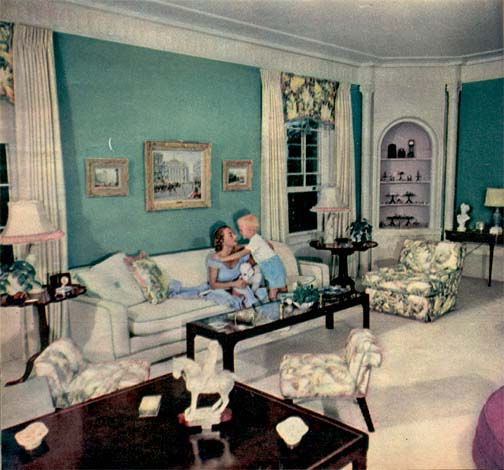
Joan and Chris in the drawing room. Modern and traditional furniture, oil paintings, Chinese porcelain lend sophistication.
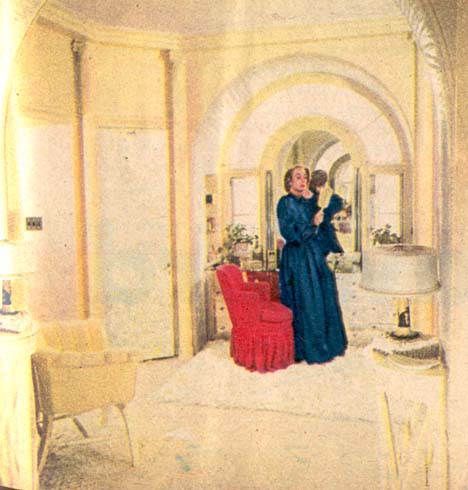
Joan's dressing room is a perfect setting for a star. It has an all-over carpet of thick white wool; quilted chintz covers the walls, and the closets are as big as rooms.

China figurines line this pine-panelled hall which leads to the dining room.
A series of Chinese murals in the dining room beyond are so delicate they're kept under glass.
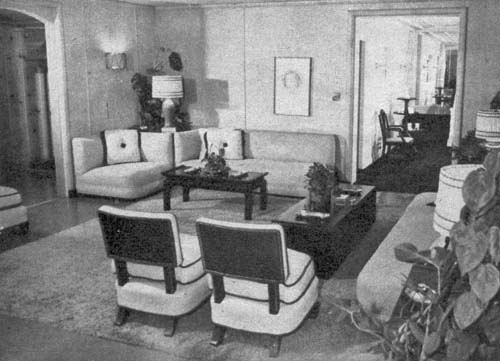
Most of Joan's entertaining is done in this playroom. The wall covering is leather, the built-in couches are sturdy, the lamps out of elbow reach.
Joan's gold Oscar and Jean Negulesco's sketch of her are here.
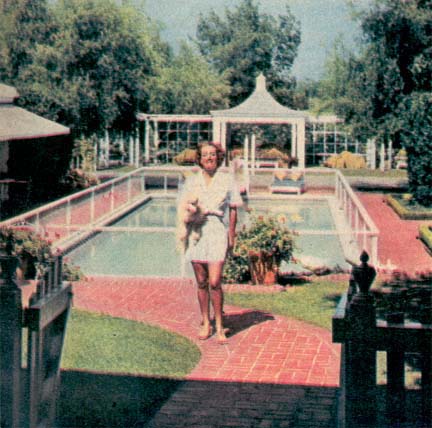
The pool is lined with blue tile, and the fence around it keeps the children out.
Building on the left has a shower and dressing room that can serve as guest quarters.

In her private, usually flower-filled sitting room on the second floor, Joan answers her personal mail, keeps her favorite books and photographs.
The Queen Anne desk contains a collection of Chinese porcelain.
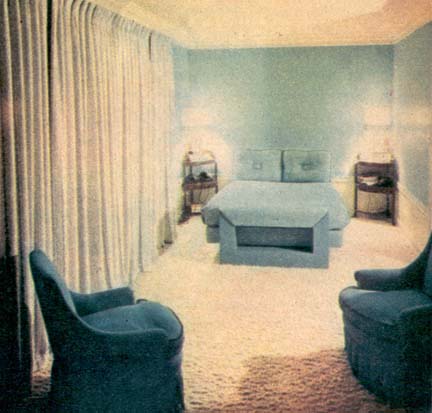
Separated from the rest of the bedroom suite is Joan's sleeping porch.
The Dorothy Liebes draperies, heavily lined with black, conceal a wall entirely composed of windows.

Joan Crawford's private theater is in a small building alongside the pool. It's as well-equipped as any full-sized theater, and movies are shown here almost every night. The stage is at the far end of the beautifully-furnished room.
This did not appear in the original article above but is a close-up view of the theater stage.
